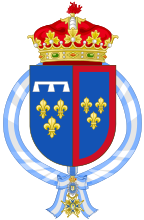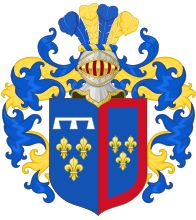| Infante Luis Fernando of Spain | |||||
|---|---|---|---|---|---|
 Photographed in uniform of the Real Maestranza de Caballería de Granada, ca. 1910 | |||||
| Born | 5 November 1888 Madrid, Spain | ||||
| Died | 20 June 1945 (aged 56) Paris, France | ||||
| Burial | Église du Cœur Immaculé de Marie | ||||
| Spouse | |||||
| |||||
| House | Orléans-Galliera | ||||
| Father | Infante Antonio, Duke of Galliera | ||||
| Mother | Infanta Eulalia of Spain | ||||
Luis Fernando de Orleans y Borbón, Infante of Spain (5 November 1888 – 20 June 1945) was a French prince and Spanish infante who lost his title.
Biography
Early life and education
Luis Fernando was born in Madrid, the younger son of Infante Antonio, Duke of Galliera and of his wife, Infanta Eulalia of Spain.
In 1899 Luis Fernando and his older brother Alfonso were sent to England to be educated by the Jesuits at Beaumont College.[1] They remained there until 1904.
Elisabeth de Gramont, Duchess of Clermont-Tonnerre, who chronicled various aspects of Parisian life in her four-volume memoirs, wrote about him: "The Infante was certainly the most divertingly cynical little creature who ever amused Paris. Slim, pallid, round- and restless-eyed like a bird, sullen looking, with lovely hands like those of a Coëllo Infanta, he promenaded his lubricious little royal person from drawing-room to awful bouges and then, ingratiatingly and affectionately, he would sink like an abandoned child at the feet of some 'Good Dame' and lament his lot."[2]
Marriage rumors and exile
On 17 July 1914 The New York Times reported the marriage of Luis Fernando to Beatrice Harrington.[3] The newspaper was mistaken, however; the groom was actually Don Luis de Borbón, Duke of Ansola.
In October 1924 Luis Fernando was expelled from France.[4] He was purportedly involved in the trade of illegal drugs. In response, King Alfonso XIII of Spain deprived him of his privileges as an Infante of Spain: "In response to the conduct observed by D. Luis Fernando María Zacarías of Orleans and Bourbon which does not allow him to bear with dignity the honours and favors that by Me have been granted upon him... I hereby decree the following: D. Luis Fernando María Zacarías of Orleans and Bourbon is deprived of the prerogatives, honours and other distinctions corresponding to the condition of Infante of Spain that were granted upon him by Royal Decree dated on 4 November 1888".
Unable to reside either in Spain or France, Luis Fernando moved to Lisbon. In March 1926 he was arrested at the Portuguese-Spanish border disguised as a woman.[5] Some smuggled goods were found in his possession, but no drugs. In 1927 he allegedly travelled to Italy in the company of Portuguese poet António Botto.[6]
In 1929 it was reported that Luis Fernando was engaged to Mabelle Gilman Corey, a Broadway actress and the former wife of William E. Corey, a steel magnate.[7] The marriage never took place.
Marriage
In July 1930 an engagement was announced between Luis Fernando and Marie Constance Charlotte Say (25 August 1857, Verrières-le-Buisson - 15 July 1943, Paris), granddaughter of Louis Auguste Say and widow of Prince Henri Amédée de Broglie and the owner of the Château de Chaumont.[8] Luis Fernando was 41 years old, while Marie was 72 years old.
Marie's nephew, François de Cossé, 11th Duke of Brissac, brought a lawsuit on behalf of her family before the Tribunal de grande instance of the Seine to try to stop the wedding.[9] He claimed that his aunt was mentally incompetent. Marie claimed that she had thought about the marriage twelve years earlier, but had delayed on account of her grandchildren. The court determined that a nephew had no legal right to oppose the marriage of an aunt.[10] It appointed a commission of three doctors to investigate Marie's mental state and confirmed a judicial administrator appointed on 7 July to manage Marie's estate.
On 19 September 1930 Luis Fernando and Marie married in a civil ceremony in a London registry office.[11] On 4 October 1930 they were married in a religious ceremony in the Cathedral of San Siro in Sanremo on the Italian Riviera.[12] After their wedding Luis Fernando and Marie lived in Sanremo in a house given to Luis Fernando by his mother.[11] In February 1935 Luis Fernando was again expelled from France.[13] He had been arrested in a vice squad raid.
Luis Fernando's wife Marie died in 1943.[14] He spent the next two years in a Paris nursing home where he died in 1945.[7] He is buried at the Église du Cœur Immaculé de Marie, 51bis rue de la Pompe, in Paris.
Legacy
Two books about Luis Fernando have been published. El infante maldito and Rey de las Maricas (The King of Queers, a title he used in jest after his official titles were removed). Both were written by Jose Carlos Garcia Rodriguez.[citation needed] Another related book, Los fantasmas de Eulalia by José Infante, reviews his mother's feelings toward her youngest son's sexuality. Infante writes that despite Eulalia's liberal views, especially with regard to female independence, she handled him cruelly.[15]
Arms
- Heraldry of Luis Fernando of Orleans
-
Coat of arms as Infante of Spain
Until 1924 -
Coat of arms after the royal title and decorations were stripped
1924-1945
Ancestry
| Ancestors of Infante Luis Fernando of Spain |
|---|
References
- ^ Bernardo Rodríguez Caparrini, "A Catholic Public School in the Making", Paedagogica Historica 39 (December 2003): 743.
- ^ Elisabeth de Gramont, Years of Plenty, translated by Florence and Victor Llona, New York: Jonathan Cape and Harrison Smith, 1931, p. 114.
- ^ "PRINCE WEDS A COMMONER.; Cousin of King Alfonso Is Married to a Pretty London Girl". The New York Times. 17 July 1914. ISSN 0362-4331. Retrieved 29 March 2023.
- ^ "A Spanish Prince’s Bad Conduct", The Times (11 October 1924): 9; "Alfonso Strips Prince Louis of Rights of Infante of Spain", The New York Times (11 October 1924): 17; "Expelled", Time (20 October 1924).
- ^ "SEIZE SPANISH PRINCE DISGUISED AS WOMAN; Customs Officials at Portuguese Border Suspect Louis Ferdinand of Smuggling". The New York Times. 26 March 1926. ISSN 0362-4331. Retrieved 29 March 2023.
- ^ António Botto, Canções e Outros Poemas, Quasi Edições, Vila Nova de Famalicão, 2008, p. 14
- ^ a b "LOUIS FERDINAND OF ROYAL FAMILY; Prince, Member of House of Bourbon-Orleans, Dies at 56 --Figured in Scandals". The New York Times. 23 June 1945. ISSN 0362-4331. Retrieved 29 March 2023.
- ^ Birkhead, May (28 September 1930). "PRINCESS WHO WED AT 73 OF LONG LINE; Her Early Ancestors Believed to Have Been English Under Henry VI. OWNED HISTORIC CHATEAU She Bought Chaumont Property in Year of Her Marriage to Prince Amedee de Broglie". The New York Times. ISSN 0362-4331. Retrieved 29 March 2023.
- ^ "Proposed Marriage of a French Princess", The Times (26 July 1930): 11; "Princess, 73, Pleads for Right to Be Happy", The New York Times (26 July 1930): 4.
- ^ "Proposed Marriage of a French Princess", The Times (28 July 1930): 11; "Aged French Princess Wins Right to Marry", The New York Times (27 July 1930): 14.
- ^ a b "Princess, 73, Weds Prince, 41, in London", The New York Times (20 September 1930): 11.
- ^ "Royal Couple Wed Again", The New York Times (5 October 1930): 29.
- ^ "France Ousts a Prince", The New York Times (17 February 1935): 8.
- ^ "Marie, Bourbon-Orleans", The New York Times (18 July 1943): 34.
- ^ Infante, José. Los fantasmas de Eulalia. Ediciones del genal.
Further reading
- José Carlos García Rodríguez. El infante maldito. La biografía de Luis Fernando de Orleans, el más depravado príncipe Borbón. Barcelona: Espasa (Grupo Editorial Planeta), 2012. ISBN 978-84-670-0428-1.
- Mateos Sáinz de Medrano, Ricardo. Los desconocidos Infantes de España: Casa de Borbón. Barcelona: Thassàlia, 1996. ISBN 84-8237-054-5.



